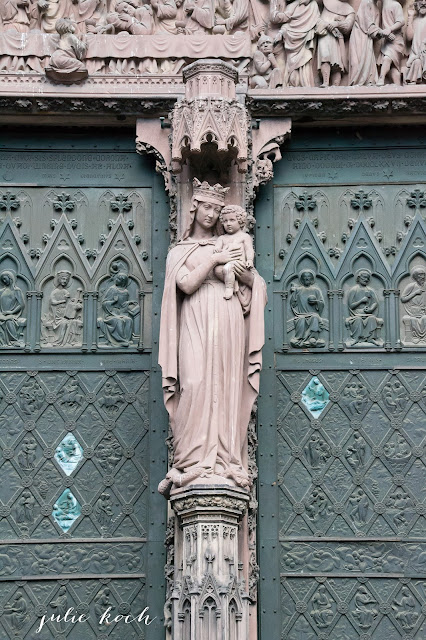So here I am to tell yall all about our trip back in April to Strasbourg, France, and a pitstop in nearby Bitche. I told you I was behind!
This wasn't our first visit to France, but...it's FRANCE. I never thought I'd get to go to France at all, much less more than once in a period of just a few months.
Most of my friends took Spanish in high school, and I was one of the few who opted to take two semesters of French instead. By no means do I remember all of it, and I am far from fluent. However, the bits that I do remember are enough to get us by when crossing over the border!
Strasbourg saw its beginnings as a Roman camp called Argentoratum. Its location on the Ill River made it perfect as a defensive fort. In 1262 A.D., Strasbourg officially became a city in the Germanic Holy Roman Empire. The area was then annexed to France in 1681. This bit of history completely explains why as soon as we saw the city, we immediately thought the architecture looked more German than French.
The French Revolution of the 18th century left much of the city destroyed. In time, the city was rebuilt and modernized. Strasbourg was returned to Germany in 1871, however, after the Franco-Prussian War. Then back to France after World War I. Then back to Germany after the Fall of France in 1940. Then back to France after liberation in 1944.
So, to recap: Roman Empire, Germany, France, Germany, France, Germany, France. Geez.
Strasbourg now serves as an important part of Europe, serving as the home of the European Parliament and of the European Ombudsman of the EU. The city center, located in Petite France (more on that below) became a World Heritage Site by UNESCO in 1988. The city's appropriate name, of Germanic origin, means "town at the crossroads".
The Barrage Vauban (below), built in the 17th century, is a covered bridge that also served as a defensive system. Today, you can cross the Ill River through the bridge, as well as climbing to the top level to enjoy a nice view of the city.
 |
| Barrage Vauban |
Ponts Couverts, literally meaning "covered bridges" in French, is an area of Strasbourg not to be missed. It consists of three bridges and four towers built in the 13th century, which are situated where the four river channels of the Ill River converge. This area is part of the Petite France quarter, which is funny because as I said before, it looks German!

We walked around Petite France for a while, making our way over to the cathedral.
Look at this cute little car Rich found! It was almost small enough to pick up and take home with us...
We watched this little guy swim around for a while! I wanted to pet him...pretty sure he wouldn't have tolerated that much.
Then there was this gal, defying gravity and such. Not sure what her story is, but this sculpture was just outside our hotel.
Place Kebler, the central square, is named for French Revolutionary War general Jean-Baptiste Kebler, who was born in Strasbourg in 1753. Kebler was killed in Cairo in 1800, but his body was eventually moved and buried in the square.
 |
| Place Kebler |
As we got closer to the cathedral, the architecture definitely began to change.
Construction of Cathédrale Notre-Dame de Strasbourg, or Cathedral of Our Lady, began in 1176 A.D. The north tower made the cathedral the world's tallest building from 1647 until 1874 when another German church took its place for the title. It's said that the world's first-documented Christmas tree was placed inside this cathedral. The custom of the Christmas tree, after all, did originate in Germany!
 |
| North Tower |
At this point, we made our way back over to Petite France to kill a little time before dinner.
 |
| This guy was just showing off... |
 |
| I don't know who Jack is, but someone needs to know where he's been. |
Strasbourg is full of history and beautiful areas that attract lots of tourists, and we weren't disappointed. In fact, we'll be going back there soon because Rich has chosen this city for a college course project he's working on. I'm certainly not complaining!
After dinner, we went back to our hotel to get some rest. The next morning, we got up and drove over to Bitche, France, very near the German border. We think you pronounce the town like "beesh".
The Bitche Citadel is a 17th century fortress that sits atop a huge rocky hill in the middle of town. It was attacked by the Prussians in 1793, and then she saw battle again during the Franco-Prussian War in 1870 as well as World War II. This thing is huge.
 |
| View of the town from the Citadel. |
 |
| Here you can see the moat that provided a little extra protection. |
 |
| Look at Richard! |
 |
| It's me! |
The outer walls were SO thick. Looking at the photo below of Rich beside it, you can get an idea.
 |
| Peek-a-boooo!! This guy makes me laugh so dang hard! |
Soldiers inside a huge fortress have to go sometimes. You know, go. But where?
After walking around the outside areas, we went down into the inside. It was dark down there so I didn't get many photos.
The fortress was completely self-sufficient, making all their own food in big kitchens with huge ovens for baking bread.
Coming back up out of the damp, cold interior, we saw the chapel before turning in our headphones and heading out.
Hope you've enjoyed our trip to Strasbourg and Bitche! I still have a few more posts before we're all caught up!






























































